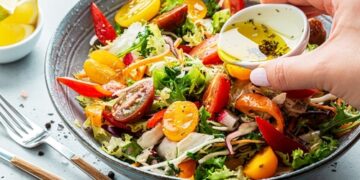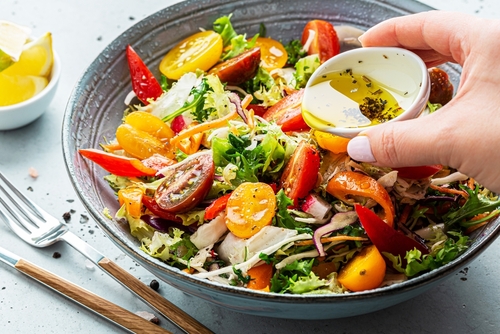When a Salad Becomes a Meal—and a Moment
Salad has suffered a bit in modern food culture. It’s often misunderstood. A side dish, a diet food, a pile of wilted greens eaten quickly before the “real” meal begins. But in a kitchen rooted in whole-food healing, salad becomes something else entirely.
A meal salad isn’t a bowl of leaves—it’s a carefully balanced harmony of texture, color, warmth, protein, fat, acid, and herbs. It’s the crackle of seeds, the creaminess of avocado, the grounding heft of legumes or roasted roots. It’s fresh, yes—but also deeply satisfying.
What makes a salad into a true meal is not just what goes into it, but how it’s built. There’s intention in every layer: healing greens that support the liver and blood, proteins that repair and nourish, and dressings that awaken digestion instead of dulling it. These are meals you eat slowly, with reverence. Meals that don’t leave you hungry, or heavy—but full, steady, and alive.
The Foundation: Greens That Do More Than Fill Space
Let’s begin at the base. The greens. This isn’t just a background—it’s the beginning of the healing.
Choose greens that are vibrant, crisp, and seasonally appropriate. Arugula brings peppery warmth. Baby kale offers strength without toughness. Romaine gives crunch and hydration. Bitter greens like dandelion or radicchio can stimulate digestion. You can mix or stay true to one—what matters most is freshness and feel.
Wash and dry them well. Don’t crowd the bowl. And always, always dress them with care.
The Body: Proteins That Ground and Hold
This is where the salad becomes a meal—not just in fullness, but in function. Protein stabilizes blood sugar, supports muscle repair, and satisfies the belly. But we don’t need to smother the bowl in meat to get there.
-
Lentils offer iron, fiber, and earthiness.
-
Chickpeas bring creaminess and density.
-
Grilled pasture-raised chicken is lean and familiar, made vibrant with herbs and citrus.
-
Seared wild salmon adds omega-3s and a satisfying richness.
-
Tofu or tempeh, when marinated and crisped, hold flavor and texture beautifully.
Each of these can transform a salad from light lunch to deeply grounding evening meal.
The Texture: Roasted Roots, Toasted Seeds, Fresh Crunch
Here is where salad becomes art. A great meal salad moves through textures. Soft lentils against crunchy fennel. Creamy avocado beside roasted carrots. A sprinkle of toasted pumpkin seeds, still warm from the pan.
Take the time to roast some vegetables at the start of the week—carrots, sweet potatoes, beets, cauliflower. Let them cool, and layer them in through the days. Toast your seeds and nuts. Keep sliced radish or cucumbers in cold water for extra snap.
These little steps give your salads life. They wake up your senses. They make you want to eat slowly, with presence.
The Heart: Healing, Homemade Dressings
The dressing is more than just flavor—it’s the delivery of healthy fat, acid for digestion, and herbs for healing.
A good dressing should glide across greens, not drown them. It should spark the appetite, brighten the bowl, and tie every ingredient together. Make it fresh. Make it simple. And don’t skip it.
Here are a few I return to often:
Herbed Tahini Dressing
Grounding, creamy, and full of depth. Perfect over lentils, root vegetables, or darker greens.
-
3 tbsp tahini
-
1 tbsp lemon juice
-
1 tsp Dijon mustard
-
1 grated garlic clove
-
2 tbsp warm water (more if needed to thin)
-
1 tbsp chopped dill or parsley
-
Sea salt and cracked pepper to taste
Whisk slowly until it turns pale and creamy. Adjust thickness as you like.
Garlic-Lime Vinaigrette
Bright, sharp, and cleansing. Ideal for grilled proteins and crisp greens.
-
3 tbsp olive oil
-
Juice of 1 lime
-
1 tsp raw honey or maple syrup
-
1 small garlic clove, crushed
-
Pinch of chili flakes (optional)
-
Salt and pepper
Shake in a jar or whisk in a bowl. Let it sit 5 minutes before using so the garlic softens.
Lemon-Basil Dressing
Fresh, floral, and light. A favorite in warm weather with grains and soft herbs.
-
2 tbsp olive oil
-
2 tbsp lemon juice
-
1 tsp Dijon
-
2 tbsp finely chopped basil
-
Sea salt and a touch of black pepper
Use immediately or store up to 2 days. Best over quinoa, chickpeas, cucumbers, or grilled zucchini.
Three Salad Bowls to Begin With
If you’re not sure where to start, here are three combinations that never fail. These are full meals—not side salads—designed to satisfy the body and leave space for the breath to deepen.
Lentil, Roasted Carrot & Arugula with Tahini Dressing
Warm lentils. Roasted carrots. Spicy arugula. Toasted pumpkin seeds. Parsley. Tossed in creamy tahini and served slightly warm. Earthy, herbaceous, and comforting.
Quinoa, Chickpea, and Cucumber Salad with Lemon-Basil Dressing
Cold and refreshing. Cooked quinoa, chickpeas, diced cucumber, bell pepper, chopped parsley, and olives. Dressed in lemon and basil, with crumbled dairy-free feta on top. This one travels well and gets better as it sits.
Grilled Chicken & Avocado on Romaine with Garlic-Lime Vinaigrette
Simple and clean. Grilled chicken slices, creamy avocado, sweet cherry tomatoes, and thin ribbons of red onion. All resting on a bed of crisp romaine. Finished with a tangy, garlicky vinaigrette and a sprinkle of hemp seeds. Perfect for late lunches or post-movement meals.
Salad as Nourishment, Not Obligation
This is what salad looks like when it’s built with care. When it becomes a meal in its own right. When it holds and supports you, rather than simply decorating the plate.
Meal salads aren’t meant to be light. They’re meant to be alive. Rich with fiber, protein, living greens, and fats that carry flavor and function. They ground the body, nourish the gut, and feed the brain.
So next time you reach for a bowl of greens, think bigger. Think warmer. Think deeper. Make it something worthy of the center of the table—and the center of your day.



























